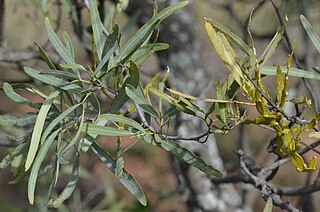
Eucalyptus pauciflora, commonly known as snow gum, cabbage gum or white sally, is a species of tree or mallee that is native to eastern Australia. It has smooth bark, lance-shaped to elliptical leaves, flower buds in clusters of between seven and fifteen, white flowers and cup-shaped, conical or hemispherical fruit. It is widespread and locally common in woodland in cold sites above 700 m (2,300 ft) altitude.

Philippe Édouard Léon Van Tieghem was a French botanist born in Baillleul in the département of Nord. He was one of the best known French botanists of the latter nineteenth century.

Tristerix is a genus of mistletoe in the family Loranthaceae, native to the Andes, ranging from Colombia and Ecuador to Chile and Argentina. They are woody perennials usually occurring as aerial parasites, are pollinated by hummingbirds and flowerpiercers, with seed-dispersal generally by birds but occasionally by mammals (Dromiciops). The genus is distinguished from other New World Loranthaceae by its simple, terminal, racemose inflorescences, together with its of 4- or 5-merous flowers, versatile anthers, and the presence of endosperm. Further differences include fused cotyledons and the absence of epicortical roots.

Amyema is a genus of semi-parasitic shrubs (mistletoes) which occur in Malesia and Australia.

Amyema miquelii, also known as box mistletoe, is a species of flowering plant, an epiphytic hemiparasitic plant of the family Loranthaceae, found attached to several species of Australian eucalypt and occasionally on some species of Acacia. It is the most widespread of the Australian Mistletoes, occurring mainly to the west of the Great Dividing Range. It has shiny leaves and red flowers arranged in groups of 3. It is distinguished from the similar Amyema pendula through the individual stalks of the flowers.

Amyema quandang is a species of hemi-parasitic shrub which is widespread throughout the mainland of Australia, especially arid inland regions, sometimes referred to as the grey mistletoe.

Dendrophthoe vitellina, commonly known as long-flowered- or apostle mistletoe, is a hemiparasitic plant of the mistletoe family Loranthaceae. The genus Dendrophthoe comprises about 31 species spread across tropical Africa, Asia, and Australia. Despite being collected by Joseph Banks and Daniel Solander in 1788, and depicted in Banks' Florilegium, it was not until 1860 that it was described by Ferdinand von Mueller as Loranthus vitellinus after being collected near Ipswich, and renamed by Philippe Édouard Léon Van Tieghem in 1895.

Amyema congener, commonly known as the variable mistletoe, is a species of flowering plant, an epiphytic hemiparasitic plant of the family Loranthaceae from eastern Australia. It is found on members of the genera Allocasuarina, Acacia and some exotic species.

Lysiana exocarpi, commonly known as harlequin mistletoe, is a species of hemiparasitic shrub, endemic to Australia. It is in the Gondwanan family Loranthaceae and is probably the most derived genus of that family with 12 pairs of chromosomes. The Loranthaceae is the most diverse family in the mistletoe group with over 900 species worldwide and including the best known species in Australia. Mistletoes are notable for their relationships with other species. In an early reference to the group in Australia Allan Cunningham explorer and first Director of the Royal Botanic Gardens, Sydney, wrote in 1817: "The Bastard Box is frequently much encumbered with the twining adhering Loranthus aurantiacus which 'Scorning the soil, aloft she springs, Shakes her red plumes and claps her golden wings'."

Muellerina is a genus of parasitic aerial shrubs in the family Loranthaceae.

Amyema gaudichaudii, commonly known as melaleuca mistletoe, is a plant in the family Loranthaceae endemic to eastern Australia. Like other mistletoes, it is a shrubby, woody, aerial hemiparasite plant. It has relatively small, wedge-shaped leaves and small, dark red flowers arranged in groups of three. It only grows on a few species of Melaleuca.

Muellerina eucalyptoides, commonly known as creeping mistletoe, is a hemiparasitic aerial shrub in the family Loranthaceae. The species is endemic to Australia.

Amyema bifurcata is an epiphytic, flowering, hemiparasitic plant of the family Loranthaceae native to Australia and found in Western Australia, the Northern Territory, Queensland and New South Wales.

Amyema melaleucae, also known as the tea-tree mistletoe, is a species of flowering plant within the genus Amyema, an epiphytic hemiparasitic plant of the family Loranthaceae native to Australia and found in Western Australia and South Australia on the coast, from north of Perth almost to the Victorian border.

Lysiana murrayi is an erect or spreading hemi-parasitic shrub in the Loranthaceae which occurs in all mainland states of Australia except Victoria. It has flat narrow leaves. The leaves are 2.5–6 cm long, 1–3.5 mm wide, do not have a distinct petiole, and the venation is not visible. The inflorescence is a solitary flower or pair of flowers without a common peduncle. The pedicels are 8–20 mm long, and strongly winged towards the apex. The spreading, membranous bracts are 2–3 mm long, and rounded at the apex. The corolla of the mature bud is usually 18–28 mm long, and white, yellow or pink. The fruit is globose, 7–12 mm long, and pink or red.

Muellerina celastroides, common names Banksia mistletoe and coast mistletoe, is a hemiparasitic aerial shrub in the family Loranthaceae. The species is endemic to New South Wales, Victoria and Queensland.

Amylotheca is a genus of hemi-parasitic aerial shrubs in the family Loranthaceae, found in Borneo, Malaysia, New Caledonia, New Guinea, Australia, Sumatra, Thailand, Vanuatu, and Philippines

Korthalsella rubra is a flowering plant in the Santalaceae (sandalwood) family, formerly placed in the Viscaceae.
Amyema plicatula is a species of hemi-parasitic shrub found in the Bismarck Archipelago, New Guinea, New South Wales and Queensland.

Amyema miraculosa, also known as the fleshy mistletoe and the round-leaf mistletoe, is an Australian native mistletoe found in all states except Tasmania. It is a woody, hemiparasitic plant, in the Loranthaceae family. Being hemiparasitic, it draws water and minerals from its host, however it photosynthesises to manufacture its own supply of carbohydrates.




















